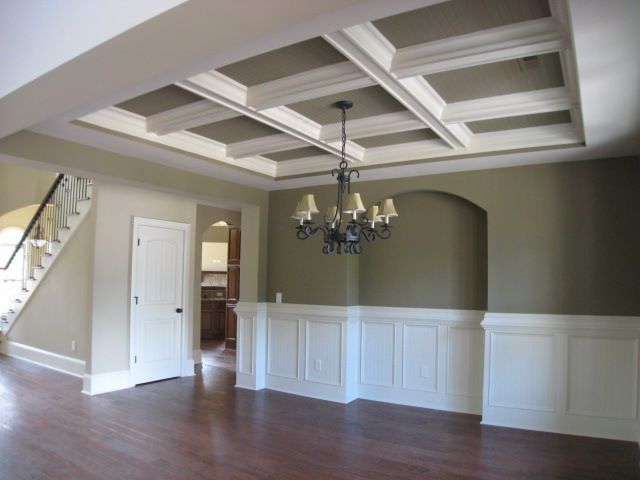How To Fix Frosting Issues On Paint
Jon Edens • March 20, 2020
Contact Your Trusted Metro North Atlanta Painters Today
Resolve Paint Frosting With These Tips
With regard to exterior painting being subject to the elements of weather, water is the main cause of many paint related issues. Paint frosting is a water-based problem that often strikes the paint on both wood and brick walls. This issue is unsightly, and it can also be damaging if left to progress for long periods of time.
As distressing as the appearance of these marks may be, frosting damage can be surprisingly simple to remedy with the right tools. Several factors are involved in frosting problems with paint, and these include moisture exposure, paint composition, and primer choice.
The moisture component forms the basis of the issue, and to successfully remove frosting marks the underlying water contamination must stop. The method used to do so largely depends on whether the surface structure is made of wood or masonry.
To minimize external water penetration, builders should seal any wood surfaces that have unprotected end-caps or joints. They should also cover the internal sides of external walls with a vapor barrier in order to prevent house-based water vapors from seeping into walls.
To preclude internal moisture accumulation, painters can protect unpainted surfaces with hydrophobic sealants. In addition, builders should avoid using paints that contain high levels of calcium carbonate. Doing so on external walls is almost asking for a frosting problem with paint.
Paint frosting is a malady can also strike interior paints that have high levels of calcium carbonate in their formulas. Many builders apply paints that contain calcium carbonate on wood or brick walls. Both of these materials are semi-permeable to water, and they are vulnerable to water infiltration if they are not properly sealed, primed, and painted. If liquid penetrates these materials, it can evaporate and then work its way to the surface through overlying layers of paint. As it does so, it can mix with water-soluble salts in the paint and leech these minerals onto the surface. As these salts solidify, they leave behind the deposits called frost marks.
Your Frosting Problem With Paint is Recoverable
Once property owners take preventative steps, they can progress to repairs. For mild frosting issues, repair persons can gently wash the affected surfaces with warm water to test the deposited crystals for water-solubility. If the marks dissolve from water-application, individuals should repeat this process until any flaws disappear.
Stubborn cases may require the use of soft bushes for gentle clearing of heavy deposits. Once excess material is cleared, they should clean the affected areas and then apply quality alkyd primers to the exposed surfaces. These primers adhere well to a wide variety of surfaces, including wood. Once the primer cures, the damaged areas can be repainted with a matching paint.
There is no doubt that frosting is a real danger to paint and a building's health. That said, property owners who use the right products for the job at hand can triumph and keep a pristine property.
You might also like

BrightSide Painting & Remodeling, a professional painting and repair company serving Metro North Atlanta, Georgia, announced the availability of professional color consultation and carpentry repair services for exterior repainting projects. Led by Jon Edens, owner and recent appointee to the Sherwin-Williams Advisory Board, the company specializes in all aspects of painting and offers a variety of services for interior and exterior residential repairs. For more details, please visit https://www.brightsidepropainting.com The newly updated services provide personalized advice from a professionally trained color consultant, allowing for tailored product recommendations and overall project guidance to fit each customer’s taste and budget. Georgia’s fluctuating, unpredictable climate leaves homes vulnerable to a wide range of harmful and potentially costly environmental conditions. With wide variations in daily temperatures across seasons and invasive considerations like rain and humidity as constant factors, finding the right time to make repairs becomes just as important as knowing what needs to be fixed. BrightSide Painting & Remodeling removes the guesswork associated with home repairs and seeks to provide reliable, long-lasting improvements capable of withstanding the elements. Emphasizing detailed planning and preparation, the company’s color consultation and exterior painting services work together to make sure a home’s structural integrity matches the appeal of its outward aesthetic. Work begins with a 90-minute in-home visit from a professionally trained Sherwin-Williams Personal Color Consultant. From that point, recommendations flow to fit the client’s personal objectives, style preferences, and budget. Exterior painting and repair considerations include assessing potential weather impact as well as determining the feasibility of desired construction materials. Work preparation addresses factors like temperature, surface types (e.g., stucco, brick, cedar, etc.), and treatment for structural compromises such as wood rot. Projects are supervised for quality and timely completion, with a final walkthrough provided for customer approval. With this announcement, BrightSide Painting & Remodeling seeks to alleviate many homeowners’ apprehensions regarding available solutions for durable, cost-effective exterior paint and repair work in the Metro North Atlanta area. A spokesperson for the company said: “Homeowners depend on paint to both beautify and protect. When it comes to ensuring that your paint project is a success, there is no more important place to start than preparation.” Interested parties can find out more information by visiting https://www.brightsidepropainting.com

Brightside Painting & Remodeling, a specialist painting and repair company serving the Metro North Atlanta, GA, area, announced the expansion of their priority and discounted services programs with the inclusion of all real estate agents throughout the state of Georgia. More details can be found at: http://brightsidepropainting.com This expansion means all real estate agents and their clients referred to BrightSide Painting & Remodeling will qualify for a 10% discount and have prioritized scheduling of estimates and project work. A recent review of the Metro Atlanta, GA, housing market noted that the market was aggressively rising. The median home price in metro Atlanta increased 17.9% in the year to January 2021 and the Atlanta housing market is expected to see one of the steepest rises in home prices for the whole of the US during 2021. The expansion of the partner program reflects the commitment of Brightside Painting & Remodeling to helping Georgia real estate agents deal with the rapidly rising housing market. Completing interior and exterior painting and repairing time-sensitive projects on residential properties without delay helps put properties on the market and close their sale more quickly, but without compromise to the professional quality of the work. Brightside Painting & Remodeling specializes in all aspects of residential painting and repair, including internal painting, external painting, deck staining and painting, and interior and external repairs. Services include complimentary estimates and onsite consultation with a specialist color consultant. More information can be found at https://www.brightsidepropainting.com/contact A spokesman said: “With this expansion of our partner program, BrightSide is committed to helping Georgia real estate agents keep pace with this roaring housing market and close for their clients without delay.” Interested parties can find more information on Brightside Painting & Remodeling at http://brightsidepropainting.com

BrightSide Painting & Remodeling, a professional residential painting and repair company based in Woodstock, Georgia, has launched an update of its services providing painting and remodeling remedies for customers in the metropolitan North Atlanta area and surrounding locales. More details can be found at https://www.brightsidepropainting.com/exterior-painting . The most recent announcement intends to supply high-quality, affordable, and comprehensive solutions for all aspects of residential painting and remodeling projects. BrightSide Painting & Remodeling offers a range of services, including interior and exterior painting jobs, deck staining, and interior and exterior repairs. The company also offers complimentary initial consultation estimates, project estimates, and color consultations, and provides on-site project supervision. For interior painting projects , the company offers the option of an in-home visit with a professionally trained SherwinWilliams Personal Color Consultant to create a custom color palette adapted to customers’ decorating styles. For interior projects, the company’s services include a detailed preparation process that covers workspace protection, wall cleaning, sanding surfaces, priming, and painting over wallpaper. For exterior painting projects , the company also offers in-home visits with professionally trained color consultants to design customized color palettes. Their thorough preparation process for outdoor projects includes planning for the weather to make sure exterior conditions do not slow down drying rates; prep work such as cleaning, drying, dulling, priming, caulking, and spraying siding; and optimally matching paints and other treatments to different kinds of exterior surfaces. Exterior painting and staining projects are on offer at 10% discounted prices during spring 2021. The company’s most recent announcement is in line with its commitment to providing high-quality products and services for residential paint and repair projects in Woodstock, Georgia, the metropolitan area of North Atlanta, and surrounding areas. A satisfied client said, "BrightSide Painting & Remodeling provided excellent service from start to finish. I appreciated the attention to detail, the professionalism of everyone who worked in my home, the honest and fair pricing, and the timely manner in which the work was completed. I am a very happy customer who would recommend them to my family and friends.” Interested parties can find more information at the above-mentioned URL.

